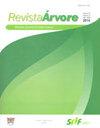COMPARATIVE ANALYSIS OF THE MECHANICAL PERFORMANCE OF TIMBER TRUSSES STRUCTURAL TYPOLOGIES APPLYING COMPUTATIONAL INTELLIGENCE
IF 0.8
4区 农林科学
Q4 FORESTRY
引用次数: 3
Abstract
ABSTRACT Timber application is viable in constructive systems because of its mechanical properties, suitable for structural applications in engineering. Timber is even more interesting to use since it is a renewable source. Among its several applications, timber is widely used in roofing structures, with several typologies of trusses. Therefore, it is necessary to understand the behavior of plane truss in different loading conditions, including dead load, service load, and wind suction load. The mechanical performance of two trusses (Pratt and Scissor) was analyzed and compared, according to the Brazilian standard of timber structures ABNT NBR 7190 (1997) (methods and calculus premises), with the finite element method, an algorithm of swarm intelligence optimization (structure weight minimization), and a parametric study. Based on minimum weight and maximum displacement as a function of span variation, Pratt typology presented lower weight (3–19%) when compared with Scissor, under the same span and loading conditions. Regarding maximum displacements, Pratt typology presented lower displacement values than the Scissor typology. The difference between these values ranged from two to seven times, indicating that Scissor typology can better distribute normal loads (maximum displacement closer to the normative limit displacement). Variance analysis (5% of significance) confirmed these results.应用计算智能对木桁架结构类型力学性能的比较分析
木材具有良好的机械性能,适合于工程结构应用,因此在建筑系统中是可行的。木材是一种可再生资源,使用起来更有趣。在它的几种应用中,木材被广泛用于屋顶结构,有几种类型的桁架。因此,有必要了解平面桁架在不同荷载条件下的性能,包括自重荷载、工作荷载和风吸力荷载。根据巴西木结构标准ABNT NBR 7190(1997)(方法和微积分前提),采用有限元法、群智能优化算法(结构重量最小化)和参数化研究,对Pratt和Scissor两种桁架的力学性能进行了分析和比较。基于最小自重和最大位移作为跨度变化的函数,在相同跨度和荷载条件下,Pratt型比Scissor型的自重低(3-19%)。在最大位移方面,Pratt类型的位移值低于scissors类型。这些值之间的差异从2倍到7倍不等,表明剪刀型可以更好地分配正常载荷(最大位移更接近规范极限位移)。方差分析(5%的显著性)证实了这些结果。
本文章由计算机程序翻译,如有差异,请以英文原文为准。
求助全文
约1分钟内获得全文
求助全文
来源期刊

Revista Arvore
FORESTRY-
CiteScore
1.00
自引率
0.00%
发文量
32
审稿时长
4-8 weeks
期刊介绍:
A Revista Árvore é um veículo de comunicação científica da Sociedade de Investigações Florestais – SIF. O jornal é de acesso gratuito, revisado por pares, que publica bimestralmente trabalhos científicos originais no campo da Ciência Florestal. As áreas temáticas para publicação são: Ambiência e Conservação da Natureza, Manejo Florestal, Silvicultura e Tecnologia da Madeira e Utilização de Produtos Florestais.
A política editorial visa manter alta conduta ética em relação à publicação e aos seus funcionários, rigor na qualidade dos artigos científicos, seleção de revisores qualificados, respeito profissional aos autores e processo de tomada de decisão imparcial. A Revista Árvore publica artigos apenas em inglês.
Artigos de revisão podem ser publicados se houver uma discussão relevante resumindo o estado da arte sobre o assunto. A revisão estrita da literatura não é aceita.
 求助内容:
求助内容: 应助结果提醒方式:
应助结果提醒方式:


